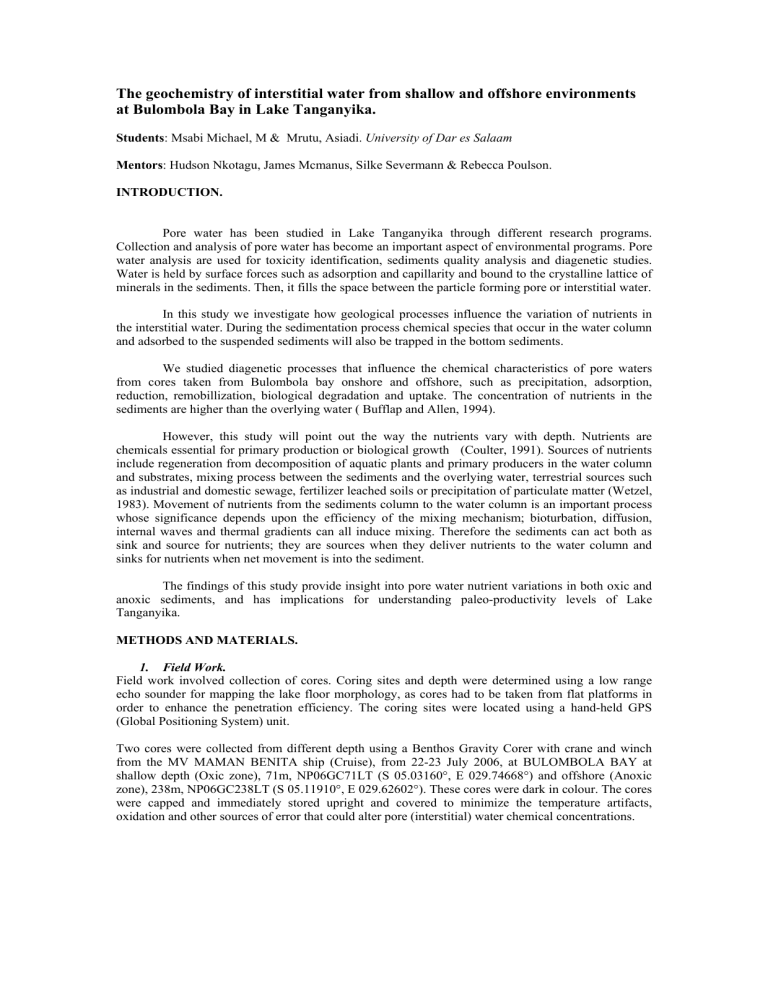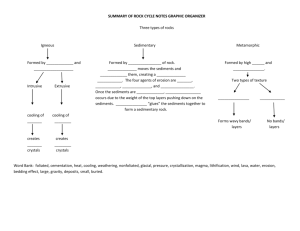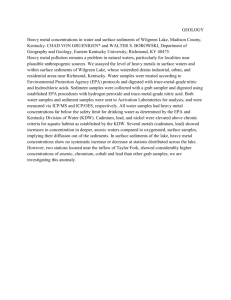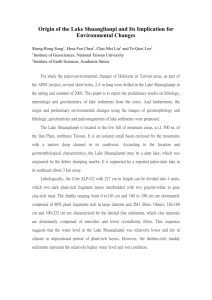The geochemistry of interstitial water from shallow and offshore environments

The geochemistry of interstitial water from shallow and offshore environments at Bulombola Bay in Lake Tanganyika.
Students : Msabi Michael, M & Mrutu, Asiadi. University of Dar es Salaam
Mentors : Hudson Nkotagu, James Mcmanus, Silke Severmann & Rebecca Poulson.
INTRODUCTION.
Pore water has been studied in Lake Tanganyika through different research programs.
Collection and analysis of pore water has become an important aspect of environmental programs. Pore water analysis are used for toxicity identification, sediments quality analysis and diagenetic studies.
Water is held by surface forces such as adsorption and capillarity and bound to the crystalline lattice of minerals in the sediments. Then, it fills the space between the particle forming pore or interstitial water.
In this study we investigate how geological processes influence the variation of nutrients in the interstitial water. During the sedimentation process chemical species that occur in the water column and adsorbed to the suspended sediments will also be trapped in the bottom sediments.
We studied diagenetic processes that influence the chemical characteristics of pore waters from cores taken from Bulombola bay onshore and offshore, such as precipitation, adsorption, reduction, remobillization, biological degradation and uptake. The concentration of nutrients in the sediments are higher than the overlying water ( Bufflap and Allen, 1994).
However, this study will point out the way the nutrients vary with depth. Nutrients are chemicals essential for primary production or biological growth (Coulter, 1991). Sources of nutrients include regeneration from decomposition of aquatic plants and primary producers in the water column and substrates, mixing process between the sediments and the overlying water, terrestrial sources such as industrial and domestic sewage, fertilizer leached soils or precipitation of particulate matter (Wetzel,
1983). Movement of nutrients from the sediments column to the water column is an important process whose significance depends upon the efficiency of the mixing mechanism; bioturbation, diffusion, internal waves and thermal gradients can all induce mixing. Therefore the sediments can act both as sink and source for nutrients; they are sources when they deliver nutrients to the water column and sinks for nutrients when net movement is into the sediment.
The findings of this study provide insight into pore water nutrient variations in both oxic and anoxic sediments, and has implications for understanding paleo-productivity levels of Lake
Tanganyika.
METHODS AND MATERIALS.
1.
Field Work.
Field work involved collection of cores. Coring sites and depth were determined using a low range echo sounder for mapping the lake floor morphology, as cores had to be taken from flat platforms in order to enhance the penetration efficiency. The coring sites were located using a hand-held GPS
(Global Positioning System) unit.
Two cores were collected from different depth using a Benthos Gravity Corer with crane and winch from the MV MAMAN BENITA ship (Cruise), from 22-23 July 2006, at BULOMBOLA BAY at shallow depth (Oxic zone), 71m, NP06GC71LT (S 05.03160°, E 029.74668°) and offshore (Anoxic zone), 238m, NP06GC238LT (S 05.11910°, E 029.62602°). These cores were dark in colour. The cores were capped and immediately stored upright and covered to minimize the temperature artifacts, oxidation and other sources of error that could alter pore (interstitial) water chemical concentrations.
2. Laboratory Work.
2.1 Sample preparation .
The cores were sectioned into two pieces each. The upper part of each core (i.e 50cm and 60cm of
NP06GC71LT and NP06GC238LT respectively) were studied because most of the chemical changes tend to take place in upper part of the sediment column.
The cores were processed in glove bags filled with nitrogen gas to prevent oxidation. Sediment sections of about 2.8cm thick were obtained by extruding the core by using a piston inserted into the bottom of the core liner. The sliced sediments were loaded into air-tight centrifuge tubes, to preclude reaction with oxygen, once the tubes are removed from the inert atmosphere and placed in the centrifuge. Six tubes were centrifuged simultaneously at 10,000 RPM for five minutes, sufficient to extract 30-40ml of pore water per sample.
The decantation of extracted pore water from the centrifuge tubes was done by disposable syringe. Some extracted pore water may contain some fine particulates in suspension especially if the sediments were disturbed during the decantation. The extracted pore water was filtered by using a
0.45µm super membrane filters mounted at the exit port at the bottom of the disposable syringe. The filtered pore water was stored in rinsed polyethylene bottles prior to geochemical analysis.
2.2: Chemical analysis of pore water.
The filtered water was diluted with deionised water to get enough water for analysis. Each 15ml of pore water were diluted to 100ml. Chemical analysis was performed following standard spectrophotometric methods as described in the HACH model DR/2400 manual. Silica was analyzed by the
Heteropoly Blue method for low range (program selected: 651 silica LR; 0.01 to 1.60 mg/L as SiO
2
).
Soluble reactive phosphorous (SRP), orthophosphate was analyzed by using phosVer 3 method
(program selected: 490 P React. PV. 0.02 to 2.50mg/L PO
4
). Nitrate analysis was done by Cadmium reduction method for low range (program selected: 351 N. Nitrate LR. 0.01 to 0.50mg/L NO
3
–N).
Iron, Total was analyzed by FerroVer ® method (program selected: 265 Iron, FerroVer; 0.02 to
3.00mg/L Fe). Nitrite was analyzed by Diazotization method for low range (program selected: 377 N,
Nitrite LR, 0.002 to 0.300 mg/L NO
2
-N). Total alkalinity was measured using titration with sulphuric acid after addition of phenolphthalein (Range 1000 – 4000mg/L as CaCO
3
).
RESULTS AND DISCUSSION.
The pore water chemical results from shallow and deep water sediments are shown in Figures 1-(a-f) and Fig.2-(a-e) respectively. The core from shallow depth shows the following mean concentrations
(mg/L): 0.34, 0.33, 0.5, 5.2, 2.21 and 503 for Nitrate, Nitrite, Phosphate, Silica, Total iron and
Alkalinity respectively. The offshore core mean concentrations were 0.74, 0.16, 0.26, 9.02 and 553 mg/l for Nitrate, Nitrite, Phosphate, Silica and Alkalinity respectively.
Silica . The core taken from deeper lake floor, NP06GC238LT, shows a general increase in silica concentration to about 24mg/L SiO
2
, while a shallow core, NP06GC71LT, shows a general increase to a maximum value of about 10mg/L SiO
2
.Both cores (shallow and offshore) show a general decrease at a depth of about 30cm and 39-45cm in Fig.1c and Fig.2d respectively. The main sources of silica in the lake water are from the dissolved rocks from the water shed through inflowing rivers. The silica is taken up by algae (i.e diatoms which have siliceous cell wall) and transferred to the sediments as the algae die and settle out.
Nitrate and Nitrite . In the anoxic environment core NO
3
decreases suddenly from the concentration of
2.6mg/L NO
3
to the minimum of about 0.06mg/L NO
3 within a short interval of depth (Figs. 2a and
2c). This is due biochemical reduction of oxidized nitrogen anion (NO
3
) forming NO
2
which shows a general increase (Wetzel, 2001).
In the oxic environment core the peak value of nitrate shows increased loading of inorganic nitrogen to lake sediments as a result of oxidation processes taking place in this zone, and hence low nitrite concentrations (Figs. 1a and 1b).
Total, Alkalinity. Pore water is generally rich in alkalinity. This is because high algal productivity can also remove carbonic acid from a lake raising carbonate precipitation. In most natural waters bicarbonates, and sometimes carbonates are present. These salts are hydrolysed in solution because of the weakness of carbonic acid (H pH (Figs. 1f and 2e).
2
CO
3
), with production of hydroxyl ions and a consequent rise in the
Phosphate and Total Iron.
In shallow water both phosphate and iron both generally increases with depth, due to the formation of soluble complexes (Figs. 1d and 1e). In the oxic environment core PO
4
due to concentration increased with depth which indicates that the sediments act as the source of PO
4 deposited organic matter decay. In the anoxic environment, phosphorous concentration fluctuated with depth (Fig. 2b).
CONCLUSION.
We observed higher concentrations of SiO
2
in the deeper water core than in the shallower water one.
In the deeper parts of the lake most sediments are from suspended and settling organisms (e.g diatoms and phytoplankton as they die), whereas in the shallower areas silica may be from clastic sediments rich in siliceous minerals. Lake sediments show much higher phosphate concentration than in the lake water column. Iron shows a general increases with depth. Nitrate and Nitrite are controlled by biochemical processes, denitrification and nitrification through nitrogen fixing bacteria, Oxidation and reduction are the predominant in processes in the shallower water sediments.
RECOMMENDATION:
Future study,is recommended in order to determine the dominant processes active in controlling pore water composition (e.g diffusion in anoxic environments) . Also the primary sampling, and preparation procedure to obtain core sediments has to be technically modified in order to obtain the most representative pore water samples for geochemical analysis. It will be necessary for future students to work out on temperature artifacts, because when sediments are displaced from their in-situ temperature chemical composition might change.
ACKNOWLEDGEMENTS.
Our field research in Lake Tanganyika was supported by the following research grants: National
Science Foundation (ATM 0223920 and DBI-0608774) through the Nyanza Project 2006 and UDSM.
Our gratitude is extended to all those bodies. We wish to acknowledge the generosity of Prof. Andy
Cohen, Catherine O’Reilly, Kiram Lezzar and Mike Soreghan as well as the visiting pore-water research team: Jim McManus, Rebecca Poulson and Silke Severmann, for their tireless support and valuable advice. Dr. Hudson Nkotagu is acknowledged for being our mentor, Willy Mbemba for helping us in lab work and so is Ellinor Michel for logistic support. Sorry that we cannot list all of the names of individuals who contributed to this study, but we acknowledge the following with gratitude:
Issa Petit, Mpape, TAFIRI staff members, the undergraduates and graduates from USA and UDSM
(Mishy, Modesta, Famida) for their encouragement and advice during the research period. Please accept our appreciation.
REFERENCES .
1. Wetzel, R. G (2001) Limnology, Lake and River Ecosystems; third Edition academic Press, USA
2. Wetzel, R. G (1983) Limnology
3. Bufflap, S.E and Allen,H.E (1994) pergamon; Sediment pore water collection methods for trace metal analysis.
4. Coulter,G.W (1991) Lake Tanganyika and its life; Oxford University press, Oxford UK.
VARIATION OF NITRITE WITH DEPTH
NO
2
- (mg/L)
0.0
0
FIG.1: a, b, c, d, e and f Æ
PROFILES FOR OXIC CHEMICAL RESULTS
(a) (b) ( c )
0.2
0.4
0.6
0.8
VARIATION OF NITRATE WITH DEPTH
0.0
0
NO
3
-
(mg/L)
0.5
1 1.5
0.0
0
VARIATION OF SILICA WITH DEPTH
SiO
2
(mg/L)
2 4 6 8 10 12
10.0
20.0
30.0
40.0
50.0
10.0
20.0
30.0
40.0
50.0
10.0
20.0
30.0
40.0
50.0
60.0
60.0
60.0
( f )
VARIATION OF PHOSPHATE WITH DEPTH
0.0
0
PO
0.5
4
3- (mg/L)
1 1.5
0.0
VARIATION OF TOTAL IRON WITH DEPTH
VARIATION OF ALKALINITY WITH DEPTH
0 2
TOTAL Fe(mg/L)
4 6 8 10
0.0
0 200
ALKALINITY (mg/L)
400 600 800
10.0
10.0
10.0
20.0
30.0
40.0
20.0
30.0
40.0
20.0
30.0
40.0
50.0
50.0
50.0
60.0
60.0
60.0
10
20
30
40
50
60
70
0
0
FIG.2: a, b, c, d and e Æ
PROFILE FOR ANOXIC CHEMICAL RESULTS:
(a) (b) (c )
VARIATION OF NITRATE WITH DEPTH VARIATION OF PHOSPHATE WITH DEPTH
VARIATION OF NITRITE WITH DEPTH
NO
3
-
(mg/L)
PO
4
- 3 (mg/L)
NO
2
- (mg/L)
0.5
1 1.5
2 2.5
3
0
0 0.1
0.2
0.3
0.4
0.5
0
0 0.1
0.2
0.3
0.4
0.5
0.6
10
20
30
40
50
10
20
30
40
50
60
60
70
70
(d) (e)
VARIATION OF SILICA WITH DEPTH
VARIATION OF ALKALINITY WITH DEPTH
0
10
20
30
40
50
60
0 5 10
SiO
2
(mg/L)
15 20 25 30
0
10
20
30
40
0 200
50
60
ALKALINITY (mg/L)
400 600 800
70 70






